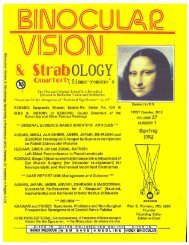Correspondence - ICO Library
Correspondence - ICO Library
Correspondence - ICO Library
You also want an ePaper? Increase the reach of your titles
YUMPU automatically turns print PDFs into web optimized ePapers that Google loves.
-55-<br />
Binocular Vision & Inferior Oblique Muscle Palsy with ‘Paradoxical’ V-Pattern Strabismus FIRST Quarter of 2011<br />
Strabology Quarterly© E. Khawam, MD and D. Fahed, MD Volume 26 (No.1)<br />
A Medical Scientific e-Periodical Pages 51-60<br />
abduction of the eye, the angle between the Y-<br />
axis of the globe and the muscle plane<br />
increases. Therefore the IO produces,<br />
increasingly, an excycloduction. Since the IO<br />
muscle is an excycloductor, an elevator, and<br />
an abductor, its paralysis therefore results in<br />
weakness of these three components:<br />
1. Torsional Deviation: The result is<br />
an intorsion of the eye. However, the absence<br />
of incyclotropia could be due to cyclofusion,<br />
or to monocular sensory adaptation whereby<br />
a reordering of the spatial response of the<br />
retinal elements along new vertical and<br />
horizontal retinal meridians, analogous to<br />
abnormal retinal correspondence (ARC). It<br />
can also be due to spread of comitance to the<br />
synergistic muscle (8) which has an opposite<br />
torsional movement: the SR muscle that has a<br />
secondary incycloduction movement.<br />
2. Vertical Deviation: The paretic eye<br />
is hypotropic if the uninvolved eye fixates. If<br />
the involved eye fixates, a hypertropia of the<br />
uninvolved eye is present. The hypotropia<br />
may become especially pronounced in<br />
adduction and depression, associated in such<br />
instances with overaction/contracture of its<br />
direct antagonist, the SO muscle.<br />
3. Horizontal Deviation: The normal<br />
abducting effect of the IO muscle is greatest in<br />
upgaze. Its paralysis, therefore, results in<br />
greater esodeviation in upgaze. And, with<br />
increasing abducting action, mainly in<br />
downgaze, of its antagonist, the SO muscle, an<br />
A-pattern esodeviation is encountered. An<br />
A-pattern exodeviation, not infrequently<br />
encountered, may develop due to the marked<br />
overaction of the SO muscle(s).<br />
4. Findings on Rotations: Weakness of<br />
the vertical action of the IO muscle, especially<br />
in the adduction position is found. However<br />
minimal weakness on rotation does not rule<br />
out the diagnosis of IO palsy.<br />
a. Overaction of its direct antagonist: the SO<br />
muscle. A prominent finding that, in<br />
my experience, is always present.<br />
b. Overaction of the yoke muscle: the SR<br />
muscle of the opposite eye. In case the<br />
affected eye is fixating in adduction, a<br />
“Rising eye phenomenon” of the fellow<br />
eye is seen in abduction.<br />
c. Underaction of the yoke of the antagonist:<br />
described by Chavasse (3) as<br />
“Inhibitional palsy of the contralateral<br />
antagonist”, the IR muscle of the<br />
opposite eye.<br />
5. Associated Secondary Mechanical<br />
Anomalies: With time, vergence-adaptation<br />
followed by muscle-length-adaptation take<br />
place: the innervationally-overacting muscles<br />
shorten with actual loss of sarcomeres<br />
resulting in contractures with structural and<br />
fascial restrictions; and the inhibitionally<br />
pseudo-palsied muscle(s) elongate with actual<br />
increased number of sarcomeres (9).<br />
6. Habitual Head Postures:<br />
a: Head Tilt: to the ipsilateral shoulder<br />
so that the affected IO muscle is put at rest<br />
and the tonic impulses, sent by the otolith<br />
apparatus will not have a direct action on it.<br />
Head tilt –we believe- is usually a<br />
compensatory mechanism to reduce the<br />
vertical deviation rather than the torsional one,<br />
and thus to gain fusion (10).









